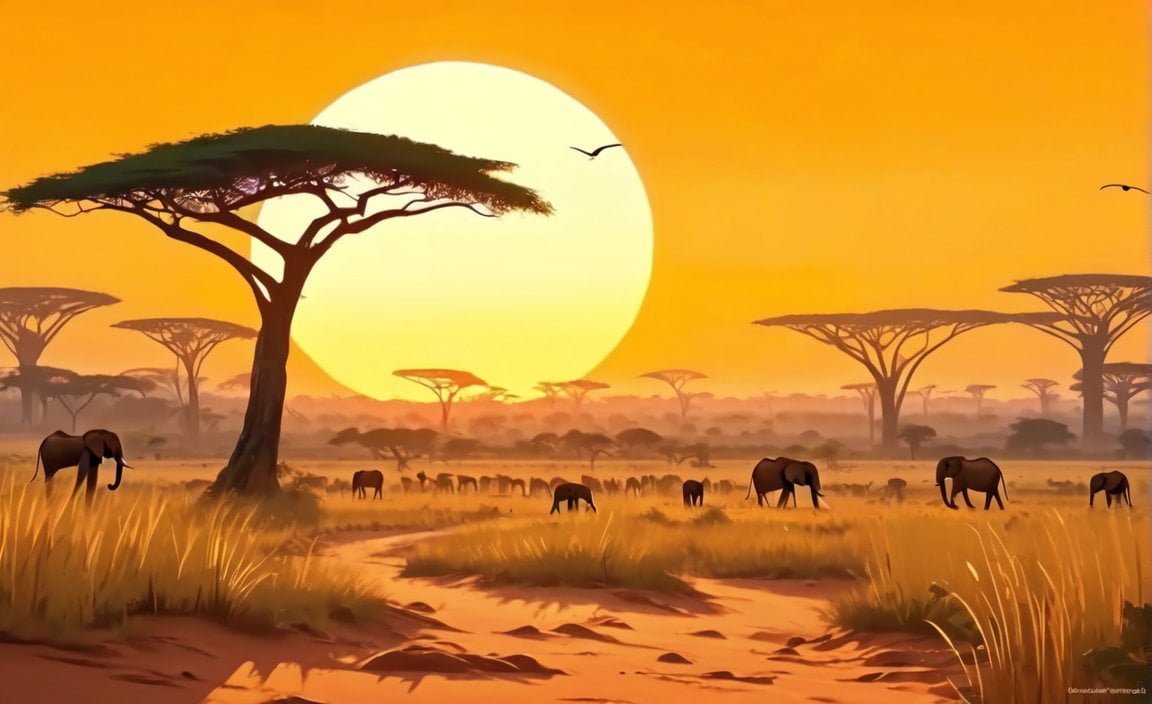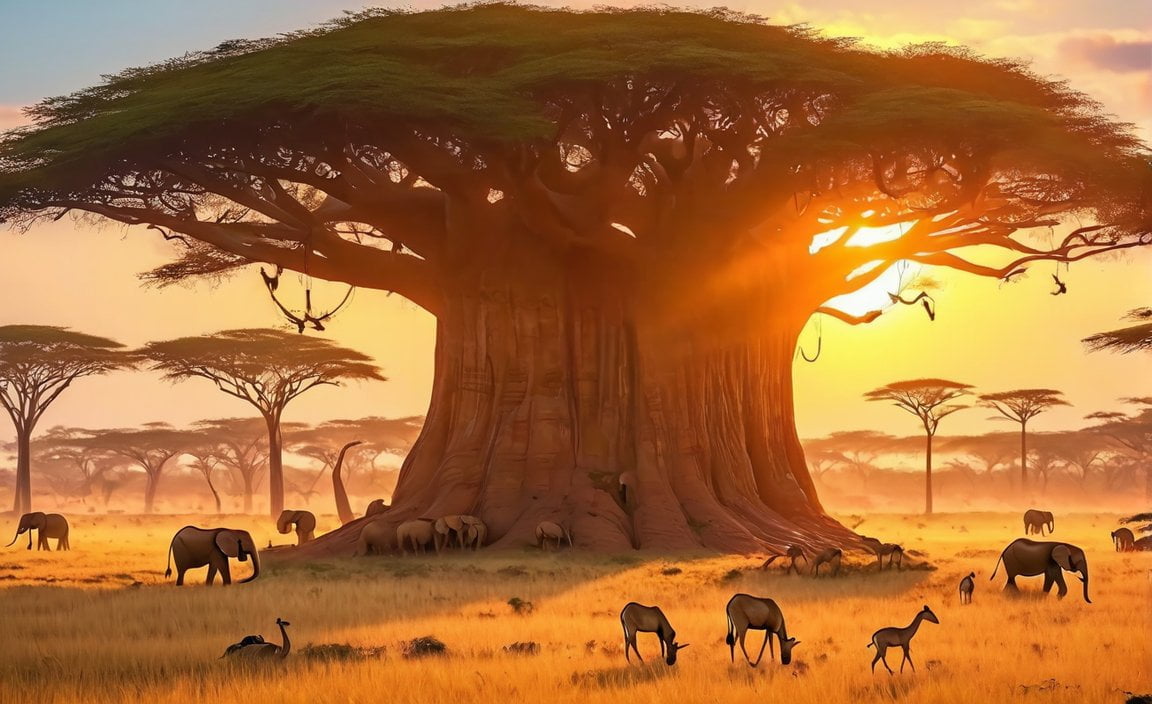If you have ever been captivated by the majestic beauty of the African savanna, prepare to be amazed. In this article, we delve into the wonders of this extraordinary ecosystem, unravelling ten fascinating facts that are sure to pique your curiosity. From the intricacies of its diverse wildlife to the resilience of its vegetation, the African savanna holds a treasure trove of secrets waiting to be discovered. So, sit back, relax, and get ready to embark on an adventure through the captivating world of the African savanna.

Key Takeaways:
- Grazing animals migrate in search of green grass, helping them survive in a landscape with scarce food sources.
- The savanna has a hot year-round climate with little seasonal temperature variation.
- Drought-resistant trees like eucalyptus, acacia, and baobab thrive in the savanna with adaptations for dry conditions.
- During wildfires, birds and large animals run to safety, while small burrowing mammals dig deep underground to escape the flames.
- The savanna experiences distinct wet and dry seasons, influencing the growth and survival of plants and animals.
- Similar grassland ecosystems to the African savanna can be found in other continents like Australia, South America, and India.
- The African savanna boasts diverse animal species such as lions, elephants, giraffes, zebras, and cheetahs, all adapted to its unique conditions.
- Plant adaptations in the savanna include deep root systems for accessing water and waxy coatings on leaves to prevent water loss.
- Savanna fires are common and important for clearing dead vegetation and promoting the growth of fire-adapted plants.
- Indigenous cultures in the savanna have traditional knowledge and practices that contribute to its conservation.
10 Fun Facts About the African Savanna
The African savanna is a captivating ecosystem that never fails to awe with its diverse wildlife and spectacular landscapes. As an avid nature journalist, I have explored this remarkable habitat extensively and uncovered some fascinating facts that are sure to spark your curiosity. Join me on this virtual journey as we dive into the wonders of the African savanna.
1. An Epic Migration to Survive
One of the most remarkable sights in the African savanna is the annual migration of grazing animals like wildebeests. In search of green grass, these resilient creatures trek across vast distances, navigating treacherous obstacles and outwitting predators. This instinctive behavior allows them to adapt and survive in a landscape where food sources may be scarce.
2. A Year-round Heatwave
When it comes to weather, the African savanna knows no moderation. This iconic habitat experiences scorching temperatures year-round, with little variation between seasons. The relentless heat creates a challenging environment for both plants and animals, pushing them to develop remarkable adaptations for survival.
3. Survival of the Fittest Trees
In the arid conditions of the savanna, only a select few trees can withstand the relentless droughts. Species such as eucalyptus, acacia, and the majestic baobab tree have evolved incredible adaptations to thrive in these conditions. Their deep root systems and other unique features allow them to access water and endure the dry spells that define the savanna.
4. Fire, Friend or Foe?
Fire roars through the savanna with mesmerizing ferocity, but the wildlife has learned to respect its power. During a wildfire, birds take to the skies, large mammals seek refuge in open areas, and small burrowing creatures find safety by tunneling deep into the earth. This instinctual behavior helps them avoid the flames and searing heat, ensuring their survival.
5. A Tale of Two Seasons
The savanna experiences distinct wet and dry seasons, each leaving a profound impact on the ecosystem. During the wet season, rainfall rejuvenates the landscape, turning the savanna into a lush haven for plants and animals alike. Conversely, the dry season puts their resilience to the test, prompting adaptations and strategies to endure the harsh conditions.
6. Beyond Africa’s Borders
While Africa undoubtedly takes center stage, the savanna ecosystem extends beyond its borders. Grassland habitats resembling the African savanna can be found in various continents, including Australia, South America, and even India. Though separated by vast distances, these ecosystems share common features and showcase the adaptability of life in grassland landscapes.
7. A Symphony of Wildlife
The African savanna is renowned for its rich and diverse wildlife. It is home to iconic species such as lions, elephants, giraffes, zebras, and cheetahs. These magnificent creatures have evolved incredible adaptations to thrive in the challenging conditions of the savanna, showcasing the remarkable wonders of nature.
8. Ingenious Plant Adaptations
Plants in the savanna have developed ingenious strategies to survive the prolonged dry periods. Some grass species possess deep roots that tap into underground water sources, ensuring their survival during droughts. Others have evolved waxy coatings on their leaves, reducing water loss and maximizing their ability to endure the scorching heat.
9. The Dance of Fire
Fire plays a vital role in shaping and maintaining the savanna ecosystem. Periodic fires help clear away dead vegetation, making way for fresh growth and supporting the proliferation of fire-adapted plants. These flames, though fearsome, contribute to the dynamic and ever-changing nature of the African savanna.
10. The Guardians of the Land
Beyond its awe-inspiring beauty and incredible wildlife, the African savanna also holds cultural significance. Indigenous communities have lived in harmony with this land for generations, nurturing a deep understanding and respect for its delicate balance. Their traditional knowledge and practices contribute to the conservation of the savanna, ensuring its preservation for future generations.
The African savanna never ceases to amaze with its sheer diversity and extraordinary wonders. From the epic migrations of grazing animals to the delicate dance between fire and life, this ecosystem is a testament to the resilience and adaptability of nature. Explore its beauty, delve into its secrets, and let the African savanna leave an indelible mark on your heart.
Table of Fun Facts about the African Savanna:
| Fact Number | Fun Fact |
|---|---|
| 1 | Grazing animals, like wildebeests, migrate in search of green grass. |
| 2 | The African savanna experiences hot temperatures throughout the year. |
| 3 | Drought-resistant trees, such as eucalyptus and acacia, thrive in the savanna. |
| 4 | Wildlife has natural instincts to escape wildfires. |
| 5 | The African savanna has distinct wet and dry seasons. |
| 6 | Grassland ecosystems similar to the African savanna can be found in other continents. |
| 7 | Lions, elephants, giraffes, zebras, and cheetahs call the savanna home. |
| 8 | Savanna plants have developed unique adaptations to survive, such as deep roots and waxy coatings. |
| 9 | Fires play a crucial role in maintaining the savanna ecosystem. |
| 10 | Indigenous cultures have a deep connection and traditional knowledge about the savanna. |
Here are some interesting facts about different biomes that you wouldn’t want to miss!
- 10 fun facts about biomes – Discover fascinating information about various biomes around the world.
- 10 fun facts about grasslands – Explore unique and surprising facts about grasslands and their diverse ecosystems.
- 10 fun facts about ponds – Dive into the world of ponds and learn intriguing facts about these aquatic habitats.
- 10 fun facts about the savanna biome – Embark on an adventure to the savanna biome and uncover captivating facts about this vast grassland ecosystem.
- 10 fun facts about taiga biome – Step into the taiga biome and unravel fascinating facts about the world’s largest terrestrial biome.
Click on the links above to delve deeper into the wonders of these biomes and expand your knowledge!
The annual wildebeest migration is a spectacular natural phenomenon that takes place in the African savanna.
The Great Wildebeest Migration is one of nature’s most incredible spectacles. It is a mesmerizing event that takes place in the African savanna, captivating the hearts of wildlife enthusiasts and photographers from all over the world. In this article, we will delve into the fascinating world of the African savanna and explore the ten most intriguing facts about this awe-inspiring habitat.
Key Takeaways:
- The Great Wildebeest Migration is a natural phenomenon that occurs in the African savanna.
- The migration is primarily driven by weather patterns and the need for food.
- The highlight of the migration is the river crossings, where wildebeest brave the waters.
- Planning ahead and choosing the right timing and location are crucial for witnessing the migration.
- Selecting a lodge strategically located near the action ensures easy access to the herds.
- Avoiding crowds of tourists is a challenge, but visiting during off-peak seasons or exploring alternative routes can provide a more intimate experience with nature.
- The wildebeest migration puts these humble creatures in the spotlight, showcasing their resilience and instinct-driven journey.
Now, let’s embark on a journey through the African savanna and uncover its wonders!
Fact 1: A Natural Dance of Survival and Abundance
The annual wildebeest migration is a remarkable display of adaptation and survival. Each year, over 1.5 million wildebeest, along with hundreds of thousands of zebras and gazelles, embark on a journey in search of fresh grazing grounds. This natural dance of survival and abundance takes them across vast stretches of the African savanna, following the rhythms of rainfall.
Fact 2: The Power of Weather
The migration is primarily influenced by weather patterns. Wildebeest move in response to the availability of food and water, driven by the need to sustain themselves and their young. Rainfall plays a crucial role in determining the timing and direction of the migration. The herds instinctively follow the green wave of new grass, constantly moving in search of nourishment.
Fact 3: The Rhythm of the Migration
While the migration is not an exact science, it follows a general pattern each year. It starts in the southern Serengeti and the Ngorongoro Conservation Area, where the wildebeest give birth to their young. As the dry season takes hold, the herds begin their epic journey towards the greener pastures of the northern Serengeti and the lush lands of the Maasai Mara in Kenya. The timing and duration of the migration can vary, but it usually takes place from July to October.
Fact 4: The Thrill of River Crossings
The river crossings are the highlight of the migration. Picture thousands of wildebeest gathering on the banks of the Mara River, their hooves stomping the ground with nervous anticipation. Suddenly, one brave individual takes the plunge, followed by a relentless cascade of wildlife. It is an awe-inspiring sight, filled with suspense and danger as crocodiles lurk in the depths of the water. Observing this spectacle is a breathtaking experience that will stay with you forever.
Fact 5: Timing is Everything
To witness the migration, timing is of the essence. If you want to be there for the river crossings, make sure you plan your visit between July and October. However, keep in mind that nature can be unpredictable, and the exact timing of the crossings can vary. Flexibility is key, as the herds’ movements depend on rainfall patterns, which can shift from year to year.
Fact 6: Finding the Perfect Spot
Choosing the right location is crucial for witnessing the migration. The Serengeti and the Maasai Mara are the main areas where the migration takes place. Research the different camps and lodges in these regions, ensuring they offer easy access to the herds. Being close to the action allows you to maximize your opportunities for witnessing the awe-inspiring moments of the migration.
Fact 7: Navigating the Crowds
Avoiding crowds of tourists can be challenging during the peak safari season. The Great Wildebeest Migration is a popular attraction, attracting visitors from all corners of the globe. If you prefer a more intimate experience with nature, consider visiting during the off-peak seasons or exploring alternative routes within the migration path. This way, you can enjoy the migration without feeling overwhelmed by the bustling crowds.
Fact 8: Shining the Spotlight on the Wildebeest
The wildebeest migration brings these often-underestimated animals into the spotlight. While lions, elephants, giraffes, and cheetahs steal the show in the African savanna, the migration allows us to appreciate the resilience and instinct-driven journey of the wildebeest. By planning ahead and researching the best viewpoints and locations, you can give these humble creatures the recognition they deserve.
Fact 9: A Spectacular Natural Phenomenon
The annual wildebeest migration is not just a journey; it is a breathtaking spectacle of nature. It reminds us of the immense power of the natural world and the grandeur of its creations. As you witness the herds crossing rivers, vast plains filled with wildlife, and the sheer scale of the migration, you can’t help but be overcome with a sense of awe and wonder.
Fact 10: Planning Ahead for an Unforgettable Experience
To make the most of this natural phenomenon, careful planning is essential. Research the best times to visit, choose the right location, and book your accommodations well in advance. Prepare yourself for the adventure of a lifetime as you witness the Great Wildebeest Migration, an unforgettable experience that will leave you in awe of the African savanna and the wonders it holds.
Remember, witnessing the Great Wildebeest Migration in the African savanna is a privilege and a chance to connect with nature on a profoundly deep level. Cherish every moment, and let the immense beauty of this spectacle touch your soul.
Sources:
– Africa Geographic
– National Geographic Society
The savanna ecosystem relies on controlled fires to maintain its balance and biodiversity.
Key Takeaways:
- Controlled fires are a vital component of the African savanna ecosystem, playing a crucial role in maintaining its balance and biodiversity.
- These fires help stimulate new growth, control invasive species, replenish nutrients in the soil, and provide habitat diversity for a wide range of plant and animal species.
The African savanna is a captivating landscape teeming with diverse wildlife and unique plant species. But did you know that this remarkable ecosystem relies on controlled fires to maintain its delicate balance and biodiversity?
1. Fire as a Regulator of Growth and Nutrient Cycling
The savanna ecosystem experiences a cycle of growth and rejuvenation, largely shaped by controlled fires. These fires help regulate the growth of vegetation, which is vital for the survival of many plant and animal species. By clearing out old and dry vegetation, these fires create space for new growth to emerge. In addition, the ashes left behind after the fire act as a natural fertilizer, replenishing the soil with essential nutrients.
2. Controlling Invasive Species
Controlled fires are an effective tool in managing invasive plant species that threaten the diversity of the savanna. These fires target invasive plants, clearing the way for native species to thrive. By reducing competition for resources, controlled fires help maintain the delicate balance of the ecosystem.
3. Providing Habitat Diversity
The African savanna supports an incredible array of plant and animal species, and controlled fires play a significant role in creating habitat diversity. Different species of plants have varying degrees of fire tolerance, and as a result, controlled fires create a mosaic of habitats with varying vegetation structure. This diverse range of habitats provides refuge for a myriad of animals, promoting biodiversity within the ecosystem.
4. Stimulating New Growth
One of the fascinating aspects of controlled fires in the savanna is their ability to stimulate new growth. Certain plant species have developed mechanisms to cope with fire, such as the ability to quickly resprout after being burned. This adaptive response ensures that fresh and nutritious vegetation becomes available for grazers, such as antelopes and zebras, shortly after a fire has passed through an area.
5. Mediating Disease Outbreaks
Controlled fires also have a positive impact on controlling disease outbreaks in the savanna ecosystem. By reducing the density of certain plants and the presence of disease-carrying organisms, these fires help to limit the spread of diseases among animal populations. This natural mechanism of disease control contributes to the overall health and sustainability of the ecosystem.
6. Natural Fire Cycles
In the African savanna, fires occur naturally, typically ignited by lightning strikes. However, it is crucial to note that controlled fires should only be carried out under specific conditions and with proper management. By mimicking natural fire cycles, controlled fires can be carefully implemented to minimize the risk of uncontrolled and destructive wildfires.
7. Sustaining Indigenous Practices
Indigenous communities have long recognized the importance of controlled fires in maintaining the health of the savanna ecosystem. Their traditional and sustainable fire management practices have been passed down through generations and have been proven effective in preserving biodiversity and promoting the overall resilience of the ecosystem.
8. Challenges and Controversies
While controlled fires have numerous benefits, their use for biodiversity conservation in savannas remains a topic of debate. Some argue that alternative management techniques, such as mechanical clearing, should be considered to reduce the reliance on fires. Finding a balance between traditional practices and modern conservation approaches is essential for preserving the delicate equilibrium of the African savanna.
In conclusion, the African savanna’s unique and awe-inspiring beauty is intricately tied to the reliance on controlled fires. These fires serve as essential tools for maintaining the balance and biodiversity of this remarkable ecosystem. By understanding and appreciating the role of controlled fires, we can further our commitment to preserving and protecting this precious habitat for generations to come.
Sources:
– Shifting fires earlier can lead to a trade-off in emissions, with a decline in burned area but an increase in emission factors due to the combustion of uncured fuels.
– The diversity of grasses in savanna ecosystems plays a significant role in determining variations in savanna fire regimes across continents.
Several Iconic Animal Species in the African Savanna
The African savanna is a magical place, teeming with diverse wildlife and breathtaking landscapes. Amongst its many treasures, several iconic animal species call this habitat their home. Lions, elephants, and giraffes, in particular, stand tall as some of the most striking and fascinating creatures found in the African savanna. In this article, we’ll delve into the wonders of this remarkable ecosystem and discover ten captivating facts about these iconic animals.
Lions: The Majestic Kings of the Savanna
Lions, often referred to as the “Kings of the Jungle,” showcase their regal prowess in the vast plains of the African savanna. Let’s uncover some intriguing facts about these majestic predators:
Social Structure and Hunting: Lions are social animals that live in groups called prides, usually consisting of related females and their offspring. Male lions, with their striking manes, protect the pride and play a vital role in defending their territory. They employ strategic hunting techniques, often relying on teamwork to bring down their prey.
Roaring Communication: Lions are known for their powerful roars, which serve as a way to communicate with one another. These distinctive calls can carry for miles, allowing lions to establish their presence, locate each other, and warn rival prides of their territorial boundaries.
Powerful Bite: Lions possess immense jaw strength, capable of exerting a force of around 650 pounds per square inch (psi). This powerful bite aids them when capturing and subduing their prey, which can include large herbivores like zebras and buffalos.
Nocturnal Lifestyle: Lions are primarily nocturnal, often venturing out to hunt under the cover of darkness. This behavior helps them avoid the intense heat of the African sun and increases their chances of a successful hunt.
Conservation Concerns: Despite their iconic status, lions face numerous threats in the wild. Habitat loss, human-wildlife conflict, and poaching contribute to their declining numbers. Efforts are underway to protect these magnificent creatures and ensure their survival for future generations.
Elephants: Giants of the African Savanna
The African savanna is also home to the awe-inspiring African elephant, a gentle giant that commands respect. Let’s uncover some fascinating facts about these magnificent creatures:
Size and Strength: African elephants are the largest land animals on Earth, growing up to 10 feet tall at the shoulder and weighing up to 6 tons. These amazing creatures possess incredible strength, capable of uprooting trees and digging for water in dry riverbeds.
Social Bonds: Elephants are highly social animals, living in complex family units known as herds. These herds are typically led by a matriarch, an experienced female who guides and protects the group. Elephants exhibit strong emotional bonds, often displaying affection and care towards one another.
Intelligent Beings: Elephants are renowned for their high levels of intelligence and exceptional memory. They possess the ability to recognize themselves in a mirror, demonstrate empathy, and exhibit problem-solving skills. Their impressive cognitive abilities allow them to learn from their environment and adapt accordingly.
Communication and Vocalizations: Elephants employ a variety of communication methods, including vocalizations, body language, and seismic vibrations. They produce a wide range of sounds, from low-frequency rumbles to trumpet-like calls, enabling them to communicate with other elephants across vast distances.
Conservation Efforts: Unfortunately, African elephants face significant threats, primarily due to habitat loss and poaching. International efforts, along with stringent anti-poaching laws and protected areas, aim to safeguard these magnificent creatures and preserve their natural habitats.
Giraffes: Graceful Giants of the Savanna
Giraffes, with their long necks and elegantly patterned coats, embody grace and beauty in the African savanna. Let’s explore some captivating facts about these enchanting creatures:
Towering Heights: Giraffes are the world’s tallest mammals, with males growing up to an astonishing height of over 5.5 meters (18 feet) and females reaching about 4.5 meters (15 feet). Their long necks assist them in foraging from tree branches that other herbivores cannot reach.
Adaptations for Survival: Giraffes have evolved extraordinary adaptations to thrive in their grassland and open woodland habitat. Their long tongues, ranging from 18 to 20 inches in length, enable them to browse leaves and shoots from trees, such as acacias, while avoiding thorns. Their mouth lining is also uniquely adapted to handle the sharp branches.
Lifespan and Conservation: In the wild, giraffes have a lifespan of up to 26 years, with slightly longer lifespans in captivity. While they are currently not classified as an endangered species, giraffes’ conservation status has been reclassified as “vulnerable” due to population declines caused by habitat loss, poaching, and human-wildlife conflict.
In conclusion, the African savanna is a treasure trove of extraordinary wildlife, with lions, elephants, and giraffes standing out as some of its most iconic inhabitants. These magnificent creatures captivate our hearts and provide valuable insights into the delicate balance of nature. By understanding and appreciating their unique qualities, we can cultivate a deeper admiration for the wonders of the African savanna and strive to protect these captivating species for generations to come.
Key Takeaways:
- Lions, elephants, and giraffes are some of the iconic animal species found in the African savanna.
- Lions exhibit a social structure, communicate through roaring, possess a powerful bite, have a nocturnal lifestyle, and face conservation concerns.
- African elephants are the largest land animals, live in social herds, are highly intelligent, use various communication methods, and require conservation efforts.
- Giraffes are the world’s tallest mammals, have adapted long necks for foraging, have a specific tongue and mouth lining, and have a vulnerable conservation status.
Sources:
National Geographic Society: Serengeti
Britannica: Giraffe

FAQ
Q1: What are some unique characteristics of the African savanna?
A1: The African savanna is characterized by its hot year-round climate, distinct wet and dry seasons, and diverse animal and plant life.
Q2: What animals can be found in the African savanna?
A2: The African savanna is home to a wide range of animals, including lions, elephants, giraffes, zebras, cheetahs, and wildebeests.
Q3: What is the significance of the Great Wildebeest Migration in the African savanna?
A3: The Great Wildebeest Migration is a natural wonder that occurs in the African savanna, where over one million wildebeests migrate following seasonal rains in search of fresh grazing grounds.
Q4: How do animals and plants in the African savanna survive in the dry conditions?
A4: Animals in the African savanna have adapted to the dry conditions by migrating in search of food and seeking shelter during wildfires. Plants have developed unique adaptations, such as deep root systems and waxy coatings, to access water and prevent water loss.
Q5: What role do savanna fires play in maintaining the ecosystem?
A5: Savanna fires are common and important for maintaining the ecosystem. They clear away dead vegetation, promote the growth of grasses and fire-adapted plants, and contribute to the overall biodiversity of the savanna.
- Star Ring Trends: Etsy vs Amazon - March 28, 2025
- Boost Pollinator Habitats: Baby Blue Eyes Sustainable Farming Guide - March 28, 2025
- Protect Big Black Bears: Effective Conservation Strategies - March 28, 2025
















